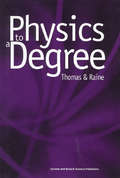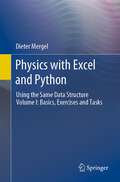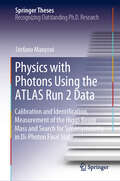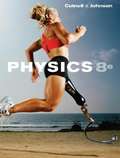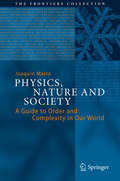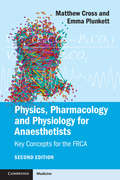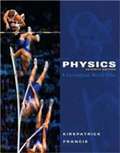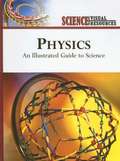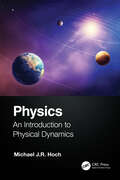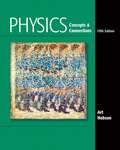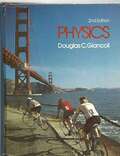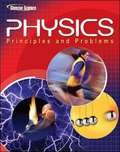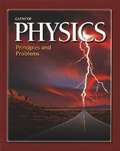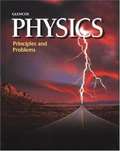- Table View
- List View
Physics to a Degree
by E.G. Thomas Derek RainePhysics to a Degree provides an extensive collection of problems suitable for self-study or tutorial and group work at the level of an undergraduate physics course. This novel set of exercises draws together the core elements of an undergraduate physics degree and provides students with the problem solving skills needed for general physics' examinations and for real-life situations encountered by the professional physicist. Topics include force, momentum, gravitation, Bernoulli's Theorem, magnetic fields, blackbody radiation, relativistic travel, mechanics near the speed of light, radioactive decay, quantum uncertainty, and much more.
Physics with Excel and Python: Using the Same Data Structure Volume I: Basics, Exercises and Tasks
by Dieter MergelThis book is intended to serve as a basic introduction to scientific computing by treating problems from various areas of physics - mechanics, optics, acoustics, and statistical reasoning in the context of the evaluation of measurements. After working through these examples, students are able to independently work on physical problems that they encounter during their studies. For every exercise, the author introduces the physical problem together with a data structure that serves as an interface to programming in Excel and Python. When a solution is achieved in one application, it can easily be translated into the other one and presumably any other platform for scientific computing. This is possible because the basic techniques of vector and matrix calculation and array broadcasting are also achieved with spreadsheet techniques, and logical queries and for-loops operate on spreadsheets from simple Visual Basic macros. So, starting to learn scientific calculation with Excel, e.g., at High School, is a targeted road to scientific computing. The primary target groups of this book are students with a major or minor subject in physics, who have interest in computational techniques and at the same time want to deepen their knowledge of physics. Math, physics and computer science teachers and Teacher Education students will also find a companion in this book to help them integrate computer techniques into their lessons. Even professional physicists who want to venture into Scientific Computing may appreciate this book.
Physics with Photons Using the ATLAS Run 2 Data: Calibration and Identification, Measurement of the Higgs Boson Mass and Search for Supersymmetry in Di-Photon Final State (Springer Theses)
by Stefano ManzoniThe work presented in this book is based on the proton-proton collision data from the Large Hadron Collider at a centre-of-mass energy of 13 TeV recorded by the ATLAS detector in 2015 and 2016. The research program of the ATLAS experiment includes the precise measurement of the parameters of the Standard Model, and the search for signals of physics beyond the SM. Both these approaches are pursued in this thesis, which presents two different analyses: the measurement of the Higgs boson mass in the di-photon decay channel, and the search for production of supersymmetric particles (gluinos, squarks or winos) in a final state containing two photons and missing transverse momentum. Finally, ATLAS detector performance studies, which are key ingredients for the two analyses outlined before, are also carried out and described.
Physics, 8th edition
by John D. Cutnell Kenneth W. Johnson Kent D. FisherDesigned for medical professionals who may struggle with making the leap to conceptual understanding and applying physics, the eighth edition continues to build transferable problem-solving skills. It includes a set of features such as Analyzing-Multiple-Concept Problems, Check Your Understanding, Concepts & Calculations, and Concepts at a Glance. This helps the reader to first identify the physics concepts, then associate the appropriate mathematical equations, and finally to work out an algebraic solution. They'll also be able to work high quality problem sets and gain immediate feedback through WileyPLUS, the online problem-solving management system. New Focus on Concept questions are featured in WileyPLUS, offering medical professionals a set of thought provoking conceptual questions as well as calculation problems.
Physics, AP* Edition (3rd Edition)
by James S. WalkerPhysics determines the behavior of everything in the universe--from the particles that make up atoms, to the tissues of the human body, to galaxies and the multitude of stars they contain. Grouped in pairs that share a common physical theme, these images touch on just a few of the many real-world applications of physics discussed in this text. As you study the material in this book, your understanding of physics will deepen. You will begin to make the connection between magnets and MRI, organ pipes and windpipes, lighthouses and magnifying glasses, hurricanes and galaxies. At the same time, your appreciation for the world around you will increase as you come to recognize the fundamental physical principles on which all of our lives are based.
Physics, Nature and Society
by Joaquín MarroThis wide-ranging and accessible book serves as a fascinating guide to the strategies and concepts that help us understand the boundaries between physics, on the one hand, and sociology, economics, and biology on the other. From cooperation and criticality to flock dynamics and fractals, the author addresses many of the topics belonging to the broad theme of complexity. He chooses excellent examples (requiring no prior mathematical knowledge) to illuminate these ideas and their implications. The lively style and clear description of the relevant models will appeal both to novices and those with an existing knowledge of the field.
Physics, Nature and Society: A Guide to Order and Complexity in Our World (The Frontiers Collection)
by Joaquín MarroThis wide-ranging and accessible book serves as a fascinating guide to the strategies and concepts that help us understand the boundaries between physics, on the one hand, and sociology, economics, and biology on the other. From cooperation and criticality to flock dynamics and fractals, the author addresses many of the topics belonging to the broad theme of complexity. He chooses excellent examples (requiring no prior mathematical knowledge) to illuminate these ideas and their implications. The lively style and clear description of the relevant models will appeal both to novices and those with an existing knowledge of the field.
Physics, Pharmacology and Physiology for Anaesthetists
by Matthew E. Cross Emma PlunkettA key requirement of the primary and final FRCA examinations is a sound understanding of the basic sciences behind anaesthetic practice. It is important to be able to describe these principles clearly, particularly in the viva section of the examinations. This fully updated new edition of a key title in the field of anaesthesia provides all the important graphs, definitions and equations which may be covered in the examinations, together with clear and concise explanations of how to present them to the examiner and why they are important. Packed full of precise, clear diagrams with well structured explanations, and with all key definitions, derivations and statistics, this is an essential study aid for all FRCA examination candidates.
Physics: A Conceptual World View (7th edition)
by Larry Kirkpatrick Gregory E. FrancisDesigned specifically for non-majors, PHYSICS: A CONCEPTUAL WORLD VIEW provides an engaging and effective introduction to physics using a flexible, fully modular presentation ideal for a wide variety of instructors and courses. Incorporating highly effective Physics Education Research pedagogy, the text features an ongoing storyline describing the development of the current physics "world view," which provides students with an understanding of the laws of nature and the context to better appreciate the importance of physics. The text's appealing style and minimal use of math also help to make complex material interesting and easier to master, even for students normally intimidated by physics or math. For instructors who want to incorporate more problem-solving skills and quantitative reasoning, the optional, more detailed, "Problem Solving to Accompany Physics: A Conceptual World View" student supplement reveals more of the beauty and power of mathematics in physics. The text can also be customized to fit any syllabus through Cengage Learning's TextChoice custom solution program. In addition, the new Seventh Edition includes a thoroughly revised art program featuring elements such as balloon captions and numerous illustrations to help students better visualize and understand key concepts.
Physics: A First Course
by Tom HsuOn each page of the student text you will find aids to help find information, understand concepts and answer questions. The book has introduction which includes sample pages with indicators that point out the page contents and reading aids.
Physics: An Illustrated Guide to Science
by Derek McmonaglePhysics: An Illustrated Guide to Science is one of eight volumes in the new Science Visual Resources set. Containing five sections, a comprehensive glossary, a Web site guide, and an index, Physics is an ideal learning tool for students and teachers of science. Full-color diagrams, graphs, charts, and maps on every page illustrate the essential elements of the subject, while parallel text provides key definitions and step-by-step explanations. The five sections include: *"Forces"--provides an overview of Newton's laws of motion and gravity. It also describes the physics of simple machines and explains the distinction between the concepts of heat and work. *"Energy"--examines the concept of energy in more detail. This section covers thermal conduction, radiation, and convection, as well as describes changes in energy type. The industrial production of energy as well as possible sources of renewable energy are also described here. *"Waves, Sound, and Light"--is concerned with the wave motion of light and sound energy. The principles of superposition, interference, diffraction, polarization, and reflection are covered in this section. There is also a survey of lenses and optical instruments. *"Electricity"--details the basic concepts of electrical energy and magnetism. Subjects covered in this section include induction, electrostatics, electric current, electromotive force, electrolysis, transformers, and electric motors. *"Electronics"--is an overview of the practical issues involved in the design of devices that control the flow of electrons or other charged particles. It includes a comprehensive guide to circuit symbols, a look at microprocessors, and a thorough grounding in circuit logic.
Physics: An Introduction to Physical Dynamics
by Michael J.R. HochPhysics: An Introduction to Physical Dynamics provides an accessible introduction to the fundamentals of physics for science and engineering undergraduates who are studying elementary physics.This textbook contains 12 chapters with accompanying problem sets and explains the dynamical properties of a variety of physical systems. The first six chapters intro- duce Newton’s laws of motion, followed by the concepts of mechanical work and mechanical energy, with illustrative applications to the translational and/or rotational motion of inflexible objects such as particles and 3D objects of fixed shape. The next four chapters generalize the application of Newton’s laws and mechanical energy to flexible systems, including flowing fluids, waves on strings, and oscillating springs. The last two chapters elucidate the laws of thermodynamics, especially heat energy transfer between systems at different temperatures.Some familiarity with topics in elementary mathematics, including calculus, is assumed. A wide variety of situations are explored, by means of which a student should acquire an enhanced understanding of the properties of physical systems from the astronomic scale to the microscopic.Key Features Covers the classical mechanics of both single particles and assemblies of particles subject to forces Contains wide-ranging sets of examples and worked problems Covers much of the material that a student might expect to encounter during the first year of a university physics course
Physics: Concepts and Connections
by Art HobsonWritten for the non-science major, this text emphasizes modern physics and the scientific process—and engages students by drawing connections between physics and everyday experience. Hobson takes a conceptual approach, with an appropriate focus on quantitative skills. <p><p>The Fifth Edition increases coverage of key environmental topics such as global warming and energy, and adds new topics such as momentum. Hobson’s text remains the least expensive textbook available for students taking non-majors physics.
Physics: Principles & Problems
by David G. Haase Paul W. Zitzewitz Kathleen A. HarperAccelerate student learning with the perfect blend of content and problem-solving strategies Physics: Principles and Problems offers you integrated support, abundant opportunities for problem solving, and a variety of realistic applications. The program has a balance of good conceptual presentation with a strong problem-solving strand. All the program resources are organized in a way that saves you preparation time and allows you to meet the needs of students in your diverse classroom.
Physics: Principles and Applications
by Douglas C. GiancoliFor algebra-based introductory physics courses taken primarily by pre-med, agricultural, technology, and architectural students. This best-selling algebra-based physics text is known for its elegant writing, engaging biological applications, and exactness. <p><p> This revised introductory algebra-based physics textbook incorporates a number of changes and updates but its basic intent and general outline remain the same. The book is intended to be readable, interesting, and accessible to students, and is meant to give them u thorough understanding of the basic concepts of physics and, by means of many interesting applications, to prepare them to use physics in their own lives and professions. It is particularly appropriate for introductory physics courses taken by students studying biology, (pre)medicine, architecture, technology, earth and environmental sciences, and other disciplines; it is also suitable for use in colleges that offer only one introductory physics course. <p><p> The goal is for students to view the world through eyes that know physics.
Physics: Principles and Problems
by Paul W. Zitzewitz James T. Murphy James M. Hollon Robert A. RothNIMAC-sourced textbook
Physics: Principles and Problems
by McGraw-HillAccelerate student learning with the perfect blend of content and problem-solving strategies! Physics: Principles and Problems offers integrated support, abundant opportunities for problem solving, and a variety of realistic applications. The program has a balance of good conceptual presentation with a strong problem-solving strand. The program resources are organized in a way that saves you preparation time and allows you to meet the needs of students in your diverse classroom.New for 2009features include more problems - Supplemental Problems, Challenge Problems, Pre-AP/Critical Thinking Problems and practice for end-of-course exams - , better math support with unique Example Problems that offer "coaching notes" to aid comprehension, and Teacher-tested lab options!
Physics: Principles and Problems
by Paul W. ZitzewitzGlencoe Physics covers: matter, energy, mechanics, waves, light, electricity and modern physics.
Physics: Principles and Problems
by Paul W. Zitzewitz T. G. ElliottAccelerate student learning with the perfect blend of content and problem-solving strategies Physics: Principles and Problems offers you integrated support, abundant opportunities for problem solving, and a variety of realistic applications. The program has a balance of good conceptual presentation with a strong problem-solving strand. All the program resources are organized in a way that saves you preparation time and allows you to meet the needs of students in your diverse classroom.
Physics: Principles and Problems (Physics:princ And Problems Ser.)
by Paul W. ZitzewitzScience textbook for high school students.
Physics: Principles and Problems, Laboratory Manual, Student Edition
by Glencoe Mcgraw-HillThe Laboratory Manual contains 53 experiments for the beginning student of physics. The experiments illustrate the concepts found in this introductory course. Both qualitative and quantitative experiments are included, requiring manipulation of apparatus, observation, and collection of data. The experiments are designed to help you utilize the processes of science to interpret data and draw conclusions.
Physics: Principles and Problems, Laboratory Manual, Student Edition
by Glencoe Mcgraw-HillThe Laboratory Manual contains 53 experiments for the beginning student of physics. The experiments illustrate the concepts found in this introductory course. Both qualitative and quantitative experiments are included, requiring manipulation of apparatus, observation, and collection of data. The experiments are designed to help you utilize the processes of science to interpret data and draw conclusions.
